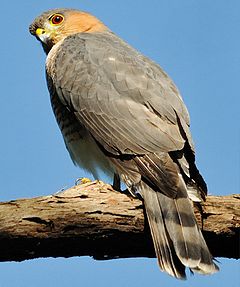Accipiter striatus venator
| Puerto Rican sharp-shinned hawk | |
|---|---|
 |
|
| Adult | |
| Scientific classification | |
| Kingdom: | Animalia |
| Phylum: | Chordata |
| Class: | Aves |
| Order: | Accipitriformes |
| Family: | Accipitridae |
| Genus: | Accipiter |
| Species: | Accipiter striatus |
| Subspecies: | Accipiter striatus venator |
| Trinomial name | |
|
Accipiter striatus venator |
|
 |
|
| Approximate range in orange | |
The Puerto Rican sharp-shinned hawk, (Accipiter striatus venator), falcón de sierra or gavilán pecho rufo in Spanish, is an endemic subspecies of the North American sharp-shinned hawk, occurring only in Puerto Rico. Discovered in 1912 and described as a distinct sub-species, it has been placed on the United States Fish and Wildlife Service list of endangered species because of its rapidly dwindling population in Puerto Rico. It can be found in the Toro Negro State Forest.
The Puerto Rican sharp-shinned hawk is a small forest hawk measuring approximately 28–33 cm (11–13 in). It has a dark blue/slate gray upper area with reddish-orange stripes on its breast. Immature birds have a brownish hue above and are striped below. It has broad wings and a proportionally long, squared-off tail, enabling it to turn and maneuver rapidly when chasing small birds through the forest canopy. The subspecies shows characteristics of sexual dimorphism, with the female almost 50% larger than the male. This allows each sex to focus their predatory efforts on different sized prey.
The Puerto Rican sharp-shinned hawk feeds primarily on small birds ranging in size from tanagers to hummingbirds. It requires a home range of approximately 150 hectares (370 acres). Females lay two to three white eggs in March or April and incubate them while the male searches for food. Average incubation period is approximately 32 days. Fledglings leave the nest 30 days after hatching.
Restricted to five isolated mountain forest areas within the subtropical lower mountain wet forests and subtropical wet forest life zones of the main island of Puerto Rico, the subspecies has suffered a 40% decline in population since 1992. As of 1997, its estimated population is approximately 150 birds. Human causes in population decline are from deforestation due to road construction, power lines, and communications facilities installations which have significantly reduced its habitat area. Natural disasters such as hurricanes also contribute significantly to population declines. Nest failures due to fledgling infestation with botfly larvae, warble fly larvae, and nest predation by the pearly-eyed thrasher (Margarops fuscatus) have also contributed to its population reduction. Although an overall population of 129 birds has been reported on the island (Delannoy, 1992), in El Yunque National Forest, the only two sharp-shinned hawks sighted at that time were a solitary territorial pair that were sighted in the south-central part of the forest.
...
Wikipedia

